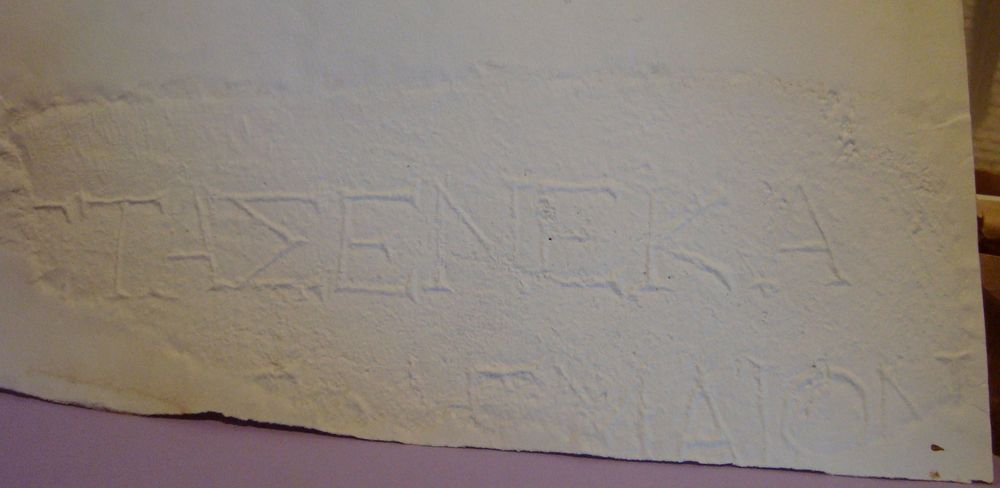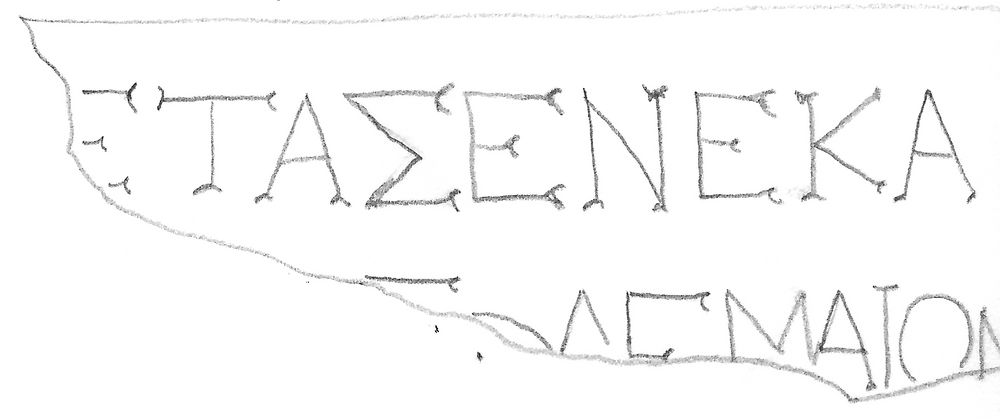EpiDoc XML:
IGCyr0635002
Trismegistos ID:
6103
Source description
Support: Fragment of a white marble base, carefully recut on top when being re-used, broken at left and below (w: 0.26 × h: 0.10 × d: 0.20).
Layout: Inscribed at 0.025 from present upper edge; the letters are packed together.
Letters: 0.023; serifs, sigma with parallel outer strokes, narrow alpha with straight bar.
Date: Late second century to 96 BC (lettering).
Findspot: Found before 1956 at Cyrene ➚: exact findspot unrecorded.
Place of origin: Findspot.
Last recorded location: Cyrene Museum, 13. Seen by C. Dobias-Lalou in 1979 in Shahat: Cyrene Museum.
Text constituted from: Transcription from stone (CDL).
Bibliography
Fraser 1958, p. 118, n. 10, pl. XIII, 10, whence SEG, 18.736; IGCyr 063500 ➚.
Text
Apparatus
2: τᾶς ἐς: [ἃς ἔχων διατελεῖ ἐς?] Fraser 1958
French translation
(scil. La statue de) [---] (scil. a été consacrée par) [---] en raison de sa valeur [et de son dévouement à l'égard du roi] Ptolémée [et de la reine Cléopatre ---].
English translation
(scil. The statue of) [---] (scil. was dedicated by) [---] on account of his valour [and his goodwilling towards king] Ptolemy [and queen Cleopatra ---].
Italian translation
[La statua di ---] (scil. è stata dedicata da) [---] in considerazione del suo valore [e della sua dedizione nei confronti del re] Tolemeo [e della regina Cleopatra ---].
Arabic translation
(تمثال) [---] (أُهْدِيَّ) [---] لأفضاله [ونواياه الحسنة تجاه الملك] بتوليميوس (بطليموس) [والملكة كليوباترا ---]
Commentary
Fragment of the dedication of a statue in honour of some dignitary having served under a Ptolemy, similar in formulation with IGCyr0633002, IGCyr0631002 and IGCyr0632002 and probably the latest of the series, to judge from the lettering. Hence the name Cleopatra restored at line 4. But which Ptolemy and which Cleopatra can not be decided.
The parallels in formulation allow to consider either that the remaining piece was a part of a very wide base, bearing in the lost part a personal name and patronymic or that the stone was recut and some preceding lines thus lost. The latter seems more plausible because there is no hole for attachment on the present upper face. However, in case the former should be right, the longer restoration proposed by Fraser would be preferable at l. 3.
The parallels in monument-type would probably lead to admit only one line missing on top and one below. But this should not be pushed forward.
The inventory number shows that the stone was already part of the epigraphic collection at the time of the reorganization of the Cyrenaean antiquities after World War II care of Goodchild (from 1956 on) and before Fraser observed it. It may well have been found already during the last years of the Italian period.
CC BY-NC-SA 4.0 Deed Attribution-NonCommercial-ShareAlike 4.0 International License.
All citation, reuse or distribution of this work must contain a link back to DOI: https://doi.org/10.60760/unibo/igcyrgvcyr2 and the filename (IGCyr000000 or GVCyr000), as well as the year of consultation.


